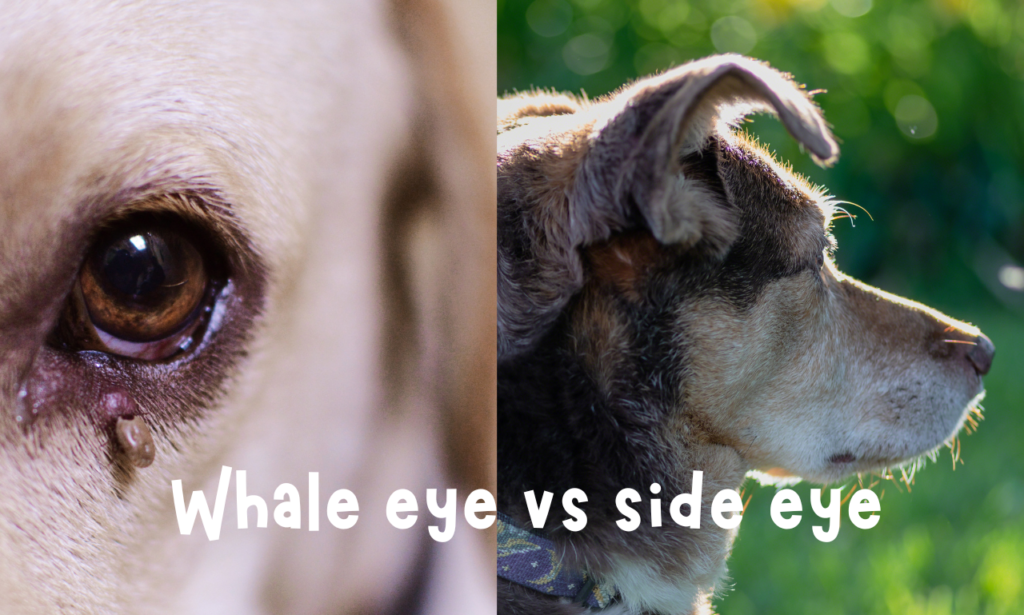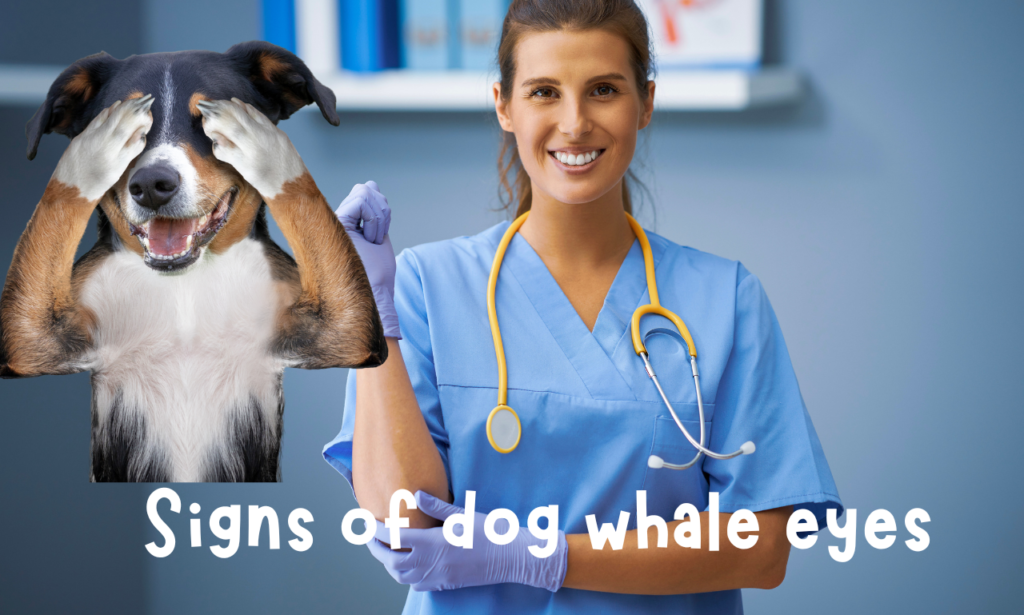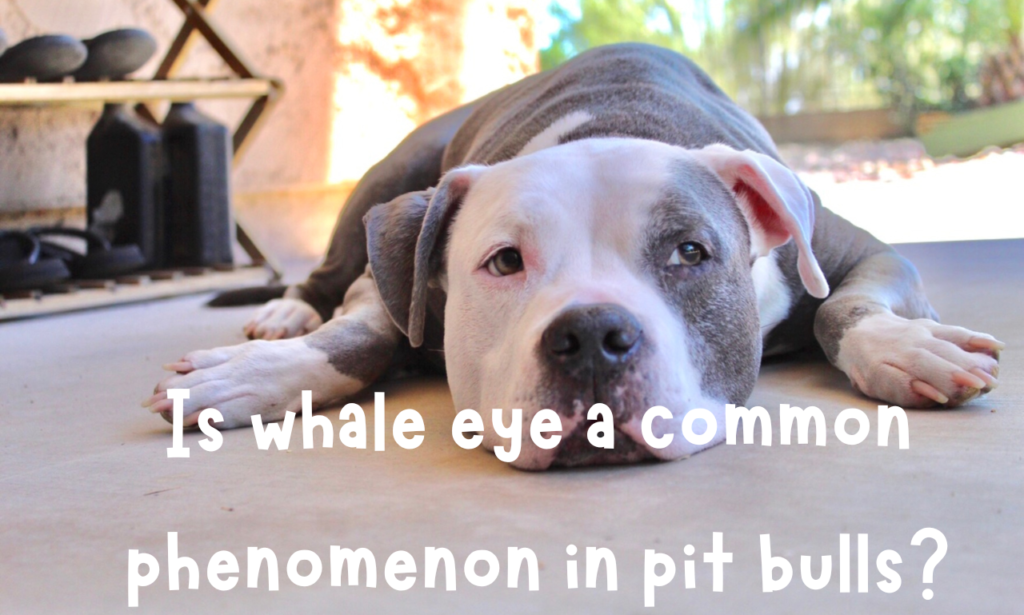


What is the meaning of dog whale eye? This is a common question that many pet parents raise. The whale eye is usually referred to a specific body language signal that can indicate stress, fear, anxiety, or discomfort. This term comes from the appearance of the dog’s eyes, which appear larger and more rounded, with a significant amount of white showing on either side of the iris. Thus, giving the impression of the eyes of a whale.
As a responsible dog owner, it is essential to recognize the signs of dog whale eye and understand the underlying causes. This article will provide a complete guide to the signs and causes of dog whale eye.
Whale eye vs side eye:

Whale eye and side eye are both body language signals that dogs use to communicate. However, they have slightly different meanings.
Whale eye is a behavior where a dog’s eyes appear larger and shows whiter on either side of the iris. This gives the impression of the eyes of a whale. It is often an indicator that the dog is feeling anxious and preparing to defend themselves if they feel threatened.
A side eye is a behavior where a dog glances at something or someone out of the corner of their eye. This can be a sign of caution, suspicion, or distrust, but it can also be playful behavior. A dog uses a side eye to keep an eye on a toy or treat while pretending to be disinterested.
Signs of dog whale eye:

Dog whale eye is a common sign of stress, fear, or anxiety in dogs. When a dog feels uncomfortable or threatened, it may display whale eyes as a warning signal to others. While the eyes are the most obvious sign of whale eyes, there are other signs that dogs may display. These include:
- Wide eyes with a lot of white showing on either side of the iris
- Stiff body posture
- Ears tucked in or pressed flat against the head.
- A tense or closed mouth
- Yawning or licking lips
- Pacing or restlessness
- Growling or barking
It is important to remember that every dog is unique, and some dogs may display whale eyes differently. However, by learning these common body language, you can better understand your dog’s feelings and take steps to help them.
Causes of dog whale eye:
A variety of factors can cause whale eyes. It is essential to identify the underlying cause to help your dog feel more relaxed and securer. Some common causes of whale eyes include:
Fear or Anxiety:
A dog may display whale eyes when feeling anxious, fearful, or stressed. This could be caused by various factors, such as loud noises, unfamiliar people or places, or other dogs.
Aggression:
Sometimes, a dog may show whale eyes as a sign of aggression. This is typically accompanied by other signs of aggression, such as growling or barking.
Medical Conditions:
Medical conditions such as eye infections or injuries can cause a dog to display whale eyes. You should consult with your veterinarian if you notice any other signs of illness, such as discharge from the eyes, redness, or swelling.
Pain or Discomfort:
Dogs may display whale eyes when they are in pain or uncomfortable. This could be due to an injury or medical condition, or it could be caused by an uncomfortable living environment or lack of socialization.
Trauma or Abuse:
Dogs that have experienced trauma or abuse may display whale eyes as a sign of fear or anxiety. If your dog has a history of trauma or abuse, providing them with a safe and supportive environment is important to help them feel more comfortable.
What to do if you notice dog whale eye:

If you notice your dog displaying whale eyes, it is essential to identify the underlying cause. Some things you can do include:
- Create a Calming Environment
- Provide Adequate Socialization
- Consult with Your Vet
- Provide Positive Reinforcement
Dog whale eye meme
Many memes on the internet feature dogs displaying whale eyes. These memes often feature humorous captions or captions that relate to the underlying causes of whale eyes in dogs. While these memes can be entertaining, it’s important to remember that dog whale eyes are often a sign of discomfort or anxiety in dogs and should be taken seriously by dog owners. Understanding and addressing the causes of whale eyes can help dogs feel more comfortable and reduce their stress levels.
Most asked question about dog whale eye
Dog whale eye while playing
While a whale eye in dogs is usually a sign of anxiety or stress, it is also possible for dogs to display this behaviour while playing. During play, dogs may become excited or aroused, and this can cause their eyes to widen and show whiter, giving the impression of whale eyes. However, in these situations, dogs typically display other body language signals that indicate that they are relaxed and having fun, such as wagging their tail, open and relaxed mouths, and loose body postures. As a dog owner, it is essential to recognize the context of your dog’s behaviour and look for other body language signals to determine whether they are feeling anxious or just having fun.
Is whale eye in dogs always evil?
While whale eyes in dogs often indicate dog anxiety or stress, it is not always a negative behaviour. In some cases, dogs may display whale eyes as a natural part of their body language without feeling discomfort or fear. Additionally, some dogs may display whale eyes as a playful expression or in response to excitement or arousal.
Dog whale eye example
An example of a dog displaying whale eyes might be a dog at the vet’s office for the first time. The dog may feel anxious or stressed in the unfamiliar environment, making their eyes appear larger and whiter on either side of the iris. Along with whale eyes, the dog may display other body language signals, such as a tense body posture, flattened ears, and restlessness. These behaviours indicate that the dog feels it may require extra care and attention from its owner or the veterinary staff.
Is whale eye a common phenomenon in pit bulls?

Whale eye Pitbull is not unique to this breed and can occur in any dog. Like all dogs, pit bulls communicate through body language. Whale eye indicates a dog is feeling anxious, stressed, or uncomfortable. Dog owners need to recognize whale eye and other body language signals. These signals include a tense body posture, flattened ears, and restlessness, indicating the dog is uncomfortable and may require extra care and attention.
Conclusion
In conclusion, the dog whale eye can signify stress, fear, anxiety, discomfort, or other underlying issues. As a dog owner, it is essential to understand the signs and causes of whale eyes and take steps to address them. With proper care and attention, you can help your dog overcome anxiety, leading to a happier and healthier life for you and your furry companion.

